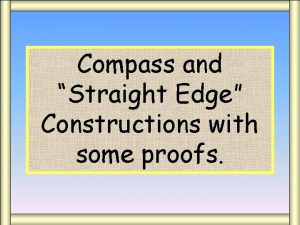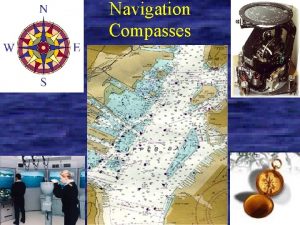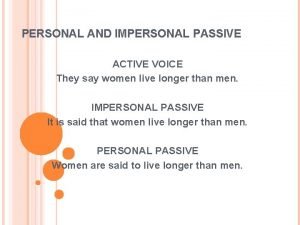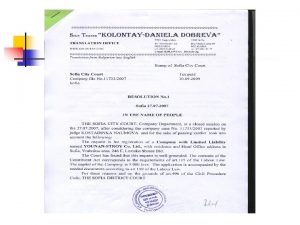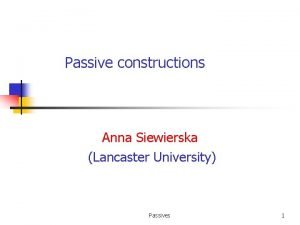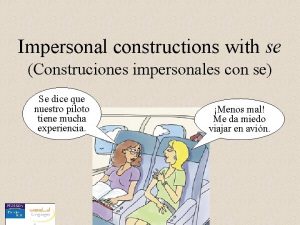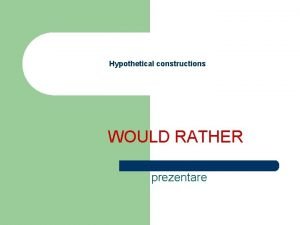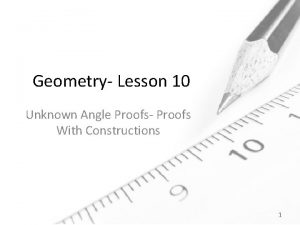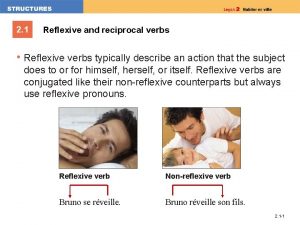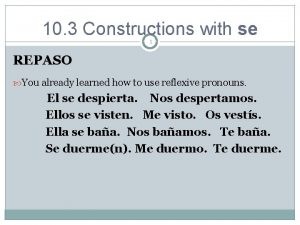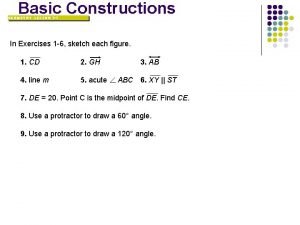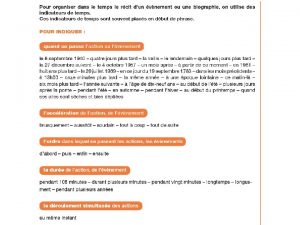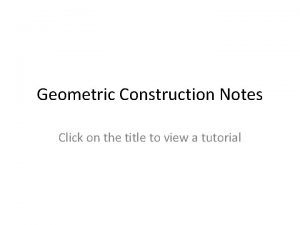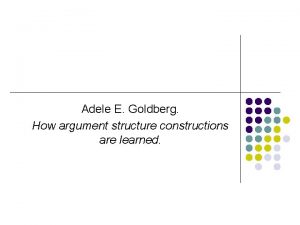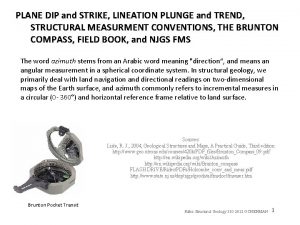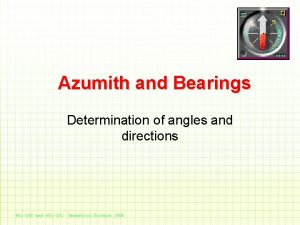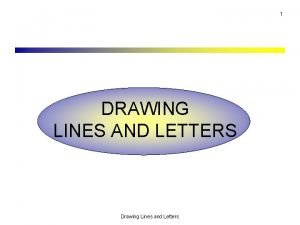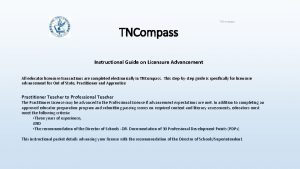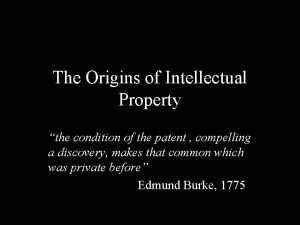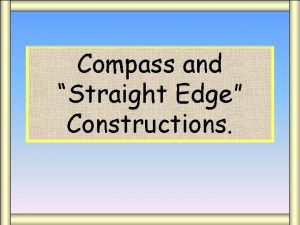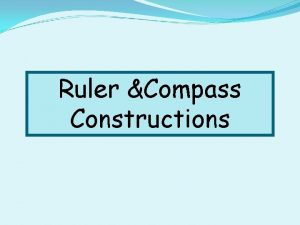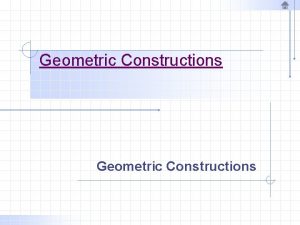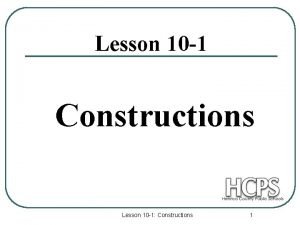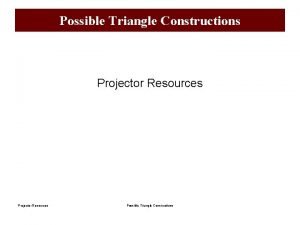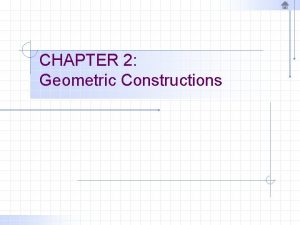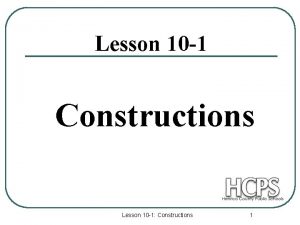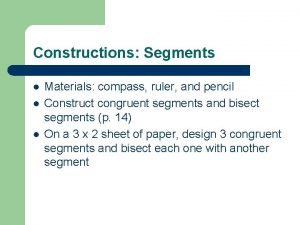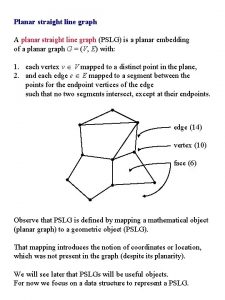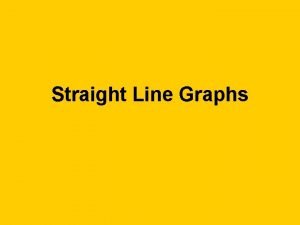Compass and Straight Edge CompassStraight Edge Constructions with


































- Slides: 34

Compass and “Straight Edge” Compass/Straight Edge Constructions with some proofs.

Constructions To Construct the Perpendicular Bisector of a line. 1. Place compass at A, set over halfway and draw 2 arcs. 2. Place compass at B, with same distance set and draw 2 arcs to intersect first two. 3. Draw the perpendicular bisector through the points of intersection. A Perpendicular B

Constructions To Construct the Angle Bisector of a given angle. 1. Place compass at A, and draw an arc crossing AB and AC. 2. Place compass at intersections and (with the same distance set) draw 2 arcs that intersect. A 3. Draw the angle bisector from A through the point of intersection. B C Angle

Constructions To Construct an Equilateral Triangle. 1. Draw base line AB of any length. 2. Place compass at A, set to distance AB and draw arc. 3. Place compass at B, with same distance set, draw an arc to intersect first one. 4. Join intersection point to A and B to form an equilateral triangle. Eq Tri A B

To Show that triangle ABC is Equilateral C Can you explain from the previous construction why O A triangle ABC is equilateral? O B AB = BC = AC all radii of the same circle

Constructions To Construct a Regular Hexagon. 1. Draw a circle of any radius. 2. With compass fixed at 1 radius place anywhere on the circumference and mark off 6 arcs. 3. Join intersections of arcs together to form a regular hexagon. Can you explain why a regular hexagon is formed? What about now? Reg Hex Each side is the base of an equilateral triangle of length equal to the radius of the circle.

Constructions To Construct an angle of 60 o. 1. Draw base line AB of any length. 2. Place compass at A, set to distance AB and draw arc. 3. Place compass at B, with same distance set and draw an arc to intersect first one. 4. Draw straight line from A through point of intersection. Angle BAC = 60 o. C 60 deg A B

Constructions To Construct an angle of 30 o. 1. Draw base line AB of any length. 2. Construct an angle of 60 o at A. 3. Bisect angle BAC. 4. Angle BAD = 30 o 30 deg C D A B

Constructions To draw a perpendicular to a given point on a line. 1. Place compass at P and with distance PA set, draw arc at C. 2. With compass at A and distance set greater than AP, draw arc above line AB. 3. Repeat with compass at C and same distance set. 4. Draw line through intersection of arcs to P. This line is perpendicular to P. D A P C B Perp Point

Constructions To Construct an angle of 45 o at any point P on a straight line. 1. Draw base line AB of any length. 2. Mark a point P anywhere on AB. 3. Construct the perpendicular to P. 4. Bisect angle BPD. D 5. Angle BPE = 45 o. A P E C B 45 deg

Constructions To Construct the Circumscribed Circle of a given triangle. The perpendicular bisectors of the sides of a triangle are co-incident at the B circumcentre. C A Circumscribed Bisect any two sides of the triangle to find the circumcentre (In this case AB and BC). Place compass at circumcentre and draw circumcircle through each vertex.

Constructions To Construct the Inscribed Circle for any given triangle. The angle bisectors of a triangle are co-incident at the Incentre. B C A Inscribed Find the incentre by taking the angle bisector of any two angles. (CAB and BCA in this case). Place compass at incentre and draw circle inside triangle.

Constructions To Construct a line through a given point P, parallel to a given line. 1. Mark off any 2 points on line AB. 2. With centre P and radius CD draw an arc adjacent to P. 3. With centre D and radius PC draw an arc to intersect the first one. 4. The line through P and the point of intersection is parallel to AB. P A C D B Parallel

Constructions To construct the perpendicular to a given line from a given point, not on the line. 1. With centre P, draw an arc of a circle that intersects AB at 2 points. 2. With centre C and compass set over ½ distance CD draw arc below AB. 3. With centre D and same distance set, draw an arc to intersect the previous one. 4. The line through P and the intersecting arcs is perpendicular to AB. P A D C B

Constructions To divide a straight line into any number of parts. (Example is into 5 parts) 1. Draw line AC at any angle to AB. 2. Use compass to mark off 5 equal line segments of any length along AC. 3. Join point of intersection on last arc to point B. 4. Draw other lines from points of intersection on AC parallel to CB to meet AB. 5. AB is now divided into 5 equal parts. C Division A B

To Prove that CD bisects AB at M. C A M B Proof 1 Bisect Line Arcs lay on the circumference of circles of equal radii. D AC = AD = BC = BD (radii of the same circle). Triangles ACD and BCD are congruent with CD common to both (SSS). So Angle ACD = BCD. Triangles CAM and CBM are congruent (SAS). Therefore AM = BM. QED

To Prove that AG is the Angle Bisector of CAB C D G F A E B Proof 2 Angle Bisect AD = AE (radii of the same circle). DG = EG (radii of the same circle). Triangle ADG is congruent to AEG (AG common to both) SSS. So angle EAG = DAG. Therefore AG is the angle bisector of CAB. QED

Constructions To prove that DEP is perpendicular to AB at P. 1. AP = PC by construction. 2. AE = CE equal radii. 3. Triangles AEP and CEP are congruent (SSS) with EP common to both. 4. So angle APE = angle CPE = 90 o (Angles on a line sum to 180 o) therefore line DEP is perpendicular to AB at P. QED. D E A P C B Proof 3 Perp Point

Compass and ruler/protractor Compass/Protractor/Ruler constructions of triangles.

Constructions To Construct a triangle, given 3 sides. Example 1: To construct a triangle of sides 8 cm, 7 cm and 6 cm. 1. Draw line 8 cm long and use as base of triangle. 2. Set compass to 7 cm, place at A and draw an arc. 3. Set compass to 6 cm, place at B and draw an arc to intersect the first one. 4. Draw straight lines from A and B to point of intersection. Tri 3 sides 7 cm A 6 cm B 8 cm

Constructions To Construct a triangle, given 3 sides. Example 2: To construct a triangle of sides 7 cm, 9 cm and 4 cm. 1. Using the longest side as the base, draw a straight line 9 cm long. 2. Set compass to 7 cm, place at A and draw an arc. 3. Set compass to 4 cm, place at B and draw an arc to intersect the first one. 4. Draw straight lines from A and B to point of intersection. 4 cm 7 cm A 9 cm B

Constructions To Construct a triangle, given 3 sides. Example 3: To construct a triangle of sides 7 cm, 3½ cm and 10 cm. 1. Using the longest side as the base, draw a straight line 10 cm long. 2. Set compass to 7 cm, place at A and draw an arc. 3. Set compass to 3½ cm, place at B and draw an arc to intersect the first one. 4. Draw straight lines from A and B to point of intersection. 7 cm A 10 cm 3½ cm B

Explain why a triangle with sides 2 cm, 10 cm and 7 cm cannot be constructed. 7 cm A 6 cm B 8 cm Under what conditions can it be guaranteed that a triangle can be constructed from 3 given lengths? 7 cm A 7 cm 4 cm A 9 cm The sum of the lengths of the smaller sides must exceed the length of the longest side. 3½ cm 10 cm B B

The table below shows lengths of sides for constructing a triangle. Which ones cannot form a triangle? Side 1 Side 2 Side 3 1 12 cm 8 cm 7 cm 2 9 cm 12 cm 4 cm 3 8 cm 15 cm 7 cm 4 18 cm 3 cm 20 cm 5 8 cm 17 cm 6 19 cm 7 cm 13 cm 7 9. 3 cm 18 cm 7. 2 cm 8 50 cm 26 cm 23 cm 9 40 cm 41 cm 82 cm 10 99 cm 2 cm 100 cm

Constructions To construct a triangle, given 1 side and 2 angles. Example 1: To construct a triangle of side, 9 cm with angles of 35 o and 65 o. 1. Draw a straight line 9 cm long. 2. Use a protractor to draw angles of 35 o and 65 o on either end of line. 3. Draw straight lines from A and B to point of intersection to form the triangle. Tri 1 side/2 angles A 9 cm B

Constructions To construct a triangle, given 1 side and 2 angles. Example 1: To construct a triangle of side, 9 cm with angles of 35 o and 65 o. 1. Draw a straight line 9 cm long. 2. Use a protractor to draw angles of 35 o and 65 o on either end of line. 3. Draw straight lines from A and B to point of intersection to form the triangle. A 65 o 35 o 9 cm B

Constructions To construct a triangle, given 1 side and 2 angles. Example 2: To construct a triangle of side, 8 cm with angles of 30 o and 100 o. 1. Draw a straight line 8 cm long. 2. Use a protractor to draw angles of 30 o and 100 o on either end of line. 3. Draw straight lines from A and B to point of intersection to form the triangle. A 8 cm B

Constructions To construct a triangle, given 1 side and 2 angles. Example 2: To construct a triangle of side, 8 cm with angles of 30 o and 100 o. 1. Draw a straight line 8 cm long. 2. Use a protractor to draw angles of 30 o and 100 o on either end of line. 3. Draw straight lines from A and B to point of intersection to form the triangle. A 30 o 100 o 8 cm B

Constructions To construct a triangle, given 2 sides and an angle. Example 1: To construct a triangle of sides, 9 cm and 7 cm with an angle of 40 o. 1. Draw a straight line 9 cm long. 2. Use a protractor to draw an angle of 40 o on either end of line. 3. Mark off a length of 7 cm. Tri 2 sides/1 angle A 9 cm B

Constructions To construct a triangle, given 2 sides and an angle. Example 1: To construct a triangle of sides, 9 cm and 7 cm with an angle of 40 o. 1. Draw a straight line 9 cm long. 2. Use a protractor to draw an angle of 40 o on either end of line. 3. Mark off a length of 7 cm. 4. Join end points to form the required triangle. 7 cm A 40 o 9 cm B

Constructions To construct a triangle, given 2 sides and an angle. Example 2: To construct a triangle of sides, 10 cm and 7 cm with an angle of 115 o. 1. Draw a straight line 10 cm long. 2. Use a protractor to draw an angle of 115 o on either end of line. 3. Mark off a length of 7 cm. A 10 cm B

Constructions To construct a triangle, given 2 sides and an angle. Example 2: To construct a triangle of sides, 10 cm and 7 cm with an angle of 115 o. 1. Draw a straight line 10 cm long. 2. Use a protractor to draw an angle of 115 o on either end of line. 3. Mark off a length of 7 cm. 4. Join end points to form the required triangle. 7 cm A 115 o 10 cm B

Constructions The Ambiguous Case In the previous constructions using SSS, SAS and ASA, all constructed triangles are congruent to each other. This is not the case when you are given SSA (that is, two sides and an angle that is not included). This situation can give rise to more than one solution. Consider the situation for a triangle with sides 9 cm, 5 cm and an angle of 30 o A 9 cm B

Constructions The Ambiguous Case In the previous constructions using SSS, SAS and ASA, all constructed triangles are congruent to each other. This is not the case when you are given SSA (that is, two sides and an angle that is not included). This situation can give rise to more than one solution. Consider the situation for a triangle with sides 9 cm, 5 cm and an angle of 30 o D This gives 2 non-congruent triangles (ABC and ABD) containing the same given sides and angle. Arc of circle of radius 5 cm centred on B. C 5 cm A 30 o 9 cm B
 Square edge constructions
Square edge constructions Whole circle bearing and quadrantal bearing
Whole circle bearing and quadrantal bearing Cdmvt example
Cdmvt example Impersonal passive form
Impersonal passive form Rising edge and falling edge
Rising edge and falling edge Yg insider trading
Yg insider trading Passive constructions
Passive constructions Spanish impersonal se
Spanish impersonal se Hypothetical constructions
Hypothetical constructions Lesson 10 unknown angle proofs-proofs with constructions
Lesson 10 unknown angle proofs-proofs with constructions Reciprocal reflexives
Reciprocal reflexives 1.3 constructions with se
1.3 constructions with se Nino constructions
Nino constructions S.bleyer
S.bleyer Chrisos civil constructions
Chrisos civil constructions 1-6 basic constructions answers
1-6 basic constructions answers Negative reflexive verbs french
Negative reflexive verbs french Impersonal passive constructions
Impersonal passive constructions Les information suivantes
Les information suivantes Draw segment sr the bisector of the vertex angle prq
Draw segment sr the bisector of the vertex angle prq Sru projects hyderabad
Sru projects hyderabad Argument structure constructions
Argument structure constructions Strike dip plunge trend
Strike dip plunge trend Compass rose with cardinal and intermediate directions
Compass rose with cardinal and intermediate directions Clock and compass time management
Clock and compass time management Principle of compass survey
Principle of compass survey In isosceles trapezoid qrst shown below
In isosceles trapezoid qrst shown below Azumith
Azumith Staples compass protractor
Staples compass protractor Map with legend compass rose and scale
Map with legend compass rose and scale Straight and curved line letters and numerals
Straight and curved line letters and numerals Wren military compass
Wren military compass Studio compass pdf
Studio compass pdf Tncompa
Tncompa Galileo military compass
Galileo military compass
